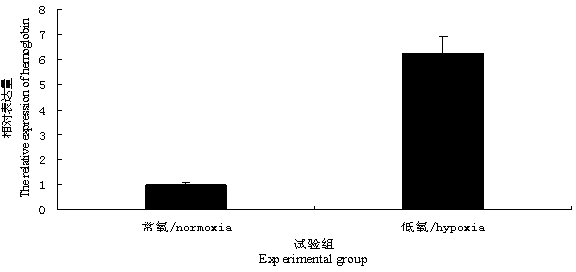Hemoglobin gene of macrobrachium nipponensis, cloning method of hemoglobin gene, and preparation method of recombinant protein
A technology of hemoglobin and Macrobrachium, applied in the direction of hemoglobin/myoglobin, genetic engineering, DNA preparation, etc., can solve problems such as poor management of artificial breeding, disease outbreaks of Macrobrachium japonica, few reports of crustacean hemoglobin, etc., and achieve strong antibacterial The effect of action
- Summary
- Abstract
- Description
- Claims
- Application Information
AI Technical Summary
Problems solved by technology
Method used
Image
Examples
Embodiment 1
[0026] Cloning of full-length cDNA sequence of hemoglobin
[0027] 1) Put 10 Macrobrachium japonicus into a glass-steel bucket, and extract RNA from the gill tissue of the shrimp. The test system includes a plastic water tank (50cm×40cm×30cm), air pump, nitrogen tank, etc. The dissolved oxygen content of the test treatment group was mainly adjusted by aeration (adjusting the ratio of air and nitrogen) to adjust the oxygen content in the water body to 2mg / L, and the air aeration group was used as the control group. During the test, the Macrobrachium japonicus temporarily kept in the water body with a dissolved oxygen content of 6.5 mg / L was moved to the water tanks with low dissolved oxygen respectively, and 20 healthy Macrobrachium japonicus in the intermolting period were stocked in each tank, and each gradient was set to Three parallel control groups were used to monitor the change of dissolved oxygen content in the water tank with a YSI-556MPS dissolved oxygen meter every 2...
Embodiment 2
[0058] Bioinformatics Analysis:
[0059] According to the obtained full-length cDNA sequence of Macrobrachium japonicus hemoglobin, using BLAST software comparison on http: / / www.ncbi.nlm.nih.gov / , it is determined that the ORF is 579bp in total, encoding 193 amino acids, see SEQ ID NO. 1. The hemoglobin gene family contains 8 conserved amino acid residue sites, the sequence of which is: Trp Phe Pro His Thr Val His Trp (SEQ ID NO.3). The conserved sequence MGXXSX (grey part) necessary for N-myristoylation in Macrobrachium japonicus hemoglobin has been found by bioinformatics methods, and N-myristoylation protein is formed on the N-terminal glycine to enhance its lipophilicity (arrows shown), confirming that hemoglobin is a cell membrane-bound protein, such as figure 2 shown. Among them, the cDNA of the hemoglobin gene is 1,201 bp in full length, has an open reading frame of 579 bp, encodes 193 amino acids, has a 5' non-coding region of 199 bp, and a 3' non-coding region of ...
Embodiment 3
[0061] Fluorescent quantitative PCR analysis:
[0062] The present invention verifies that Macrobrachium japonicus hemoglobin participates in the molecular process of hypoxic stress, image 3 It indicated that the hemoglobin of Macrobrachium japonicus was significantly increased under hypoxic stress. In this example, the detection method of hemoglobin fluorescent quantitative PCR will be introduced.
[0063] Fluorescent quantitative PCR (qRT-PCR) is an electrophoretic analysis method that uses the characteristics of a highly sensitive DNA fluorescent dye—SYBR Green 1 combined with dsDNA to release a fluorescent signal to indicate the amount of the target gene amplification product. For Macrobrachium japonicus hemoglobin gene and β-actin gene, using the reverse transcription solution as a template, use qRT-PCR-F: 5'GGTCTTCAAAGGTTGGAGCA3'(SEQ ID NO.6); qRT-PCR-R: 5'GTTCGGTGCCTTAGAGTGAG3'( SEQ ID NO.7) to amplify these two genes, the reaction system is as follows:
[0064] ...
PUM
 Login to View More
Login to View More Abstract
Description
Claims
Application Information
 Login to View More
Login to View More - R&D
- Intellectual Property
- Life Sciences
- Materials
- Tech Scout
- Unparalleled Data Quality
- Higher Quality Content
- 60% Fewer Hallucinations
Browse by: Latest US Patents, China's latest patents, Technical Efficacy Thesaurus, Application Domain, Technology Topic, Popular Technical Reports.
© 2025 PatSnap. All rights reserved.Legal|Privacy policy|Modern Slavery Act Transparency Statement|Sitemap|About US| Contact US: help@patsnap.com



